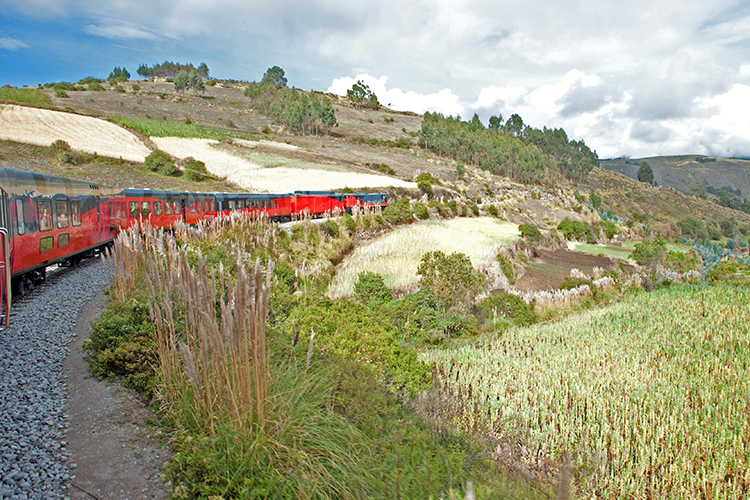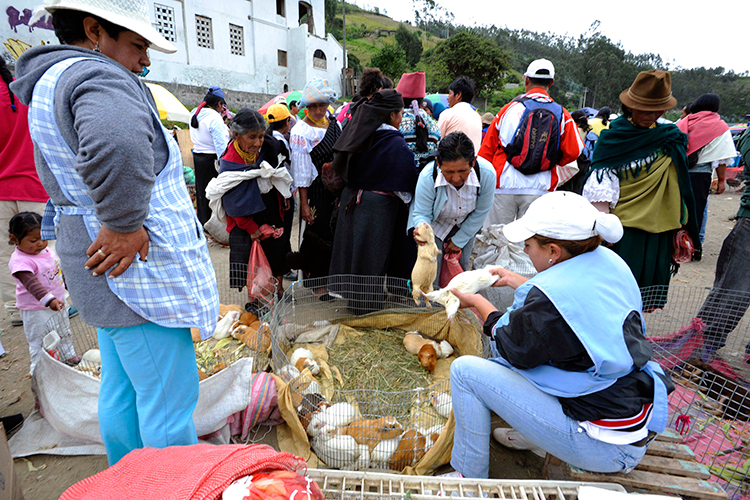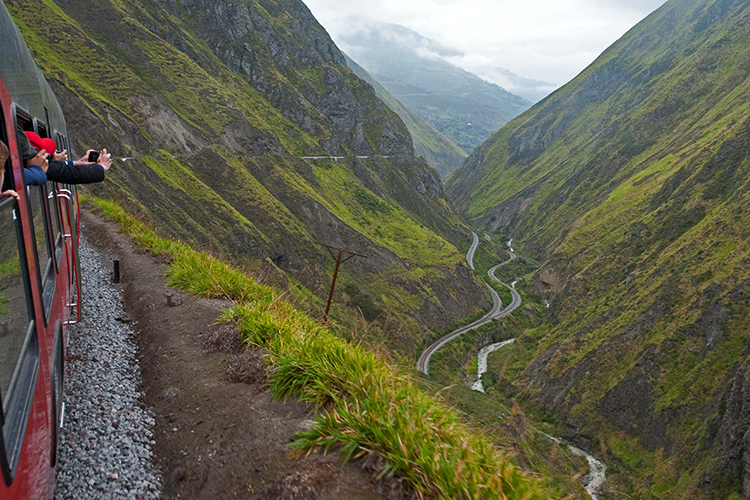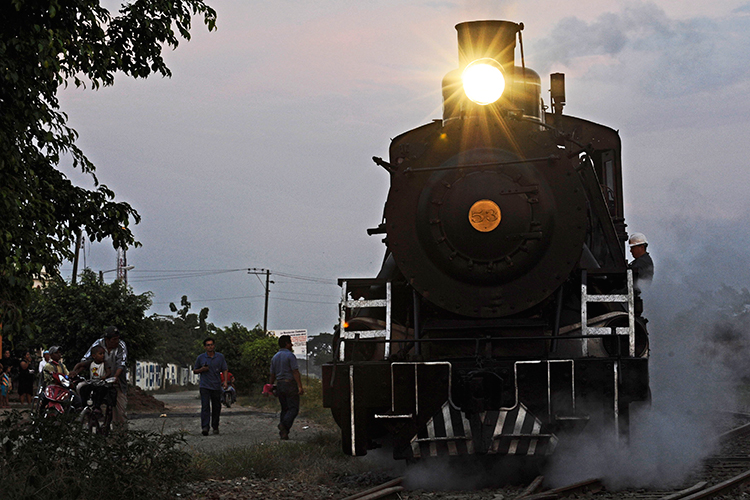
The Tren Crucero passing through Andean farmland between Riobamba and Colta stations. Image by Amar Grover / Lonely Planet.
It could have been called the 'cursed railway'. In the late 1800s initial attempts to build a line connecting the tropical lowlands to the Andean highlands proved difficult, as its builders found themselves bedevilled by pestilence, plagues, malaria and snakebites. The infrastructure fared as badly as the workforce: floods, storms and landslides ensured that most of what was constructed in one season was almost completely wrecked by the start of the next. Meanwhile, Ecuador’s two main cities remained separated by arduous journeys involving mules and carts.
But Eloy Alfaro, the fin de siècle Ecuadorian President known locally as the 'Old Warrior', was determined to modernise his country. He persevered with his American contractors, the tenacious Harman brothers, who finally delivered a through line in 1908. For many decades trains chugged up and down the spectacular route. Yet over time it became neglected, segmented and unreliable. By the 1970s roads offered a quicker, more practical way to make the journey, and the railway had seemingly evolved into a kind of novelty line for younger travellers riding atop the roofs of its shabby carriages.
Today, after a lengthy programme of rebuilding and upgrades costing millions of dollars, the 448km-long railway operates again along the entire route.

Vendors selling guinea pigs in Otavalo's market, Ecuador. Image by Amar Grover / Lonely Planet.
Tren Crucero (www.ecuadorbytrain.com) is an upmarket train offering an upmarket experience. If you simply want to travel from Quito to Guayaquil (or vice versa), there are faster and cheaper alternatives. But if you want a four-day/three-night itinerary complete with meals and sightseeing, it’s a great, varied way to make the trip. You can also join the train for a day trip or book a shorter itinerary. Every seat ‒ 54 upright armchairs ‒ is a window seat and together they occupy just two carriages.
There’s also a lounge and bar car serving snacks, drinks and beverages, and, best of all, an observation car with sofas and an open end-of-train ‘veranda’. You can move between them at will and some passengers literally hang out on the latter for much of the journey. Only when navigating the famous Devil’s Nose might the crew need to ration time out on the train’s veranda.
The sightseeing element also means you’ll travel between some sites by bus. The aim here is not merely to make the best use of time ‒ some attractions are simply not alongside the railway. You'll eat lunches in restaurants and spend nights in comfortable hotels, ranging from an atmospheric hacienda to a rustic inn.

The Tren Crucero descending from the Devil's Nose. Image by Amar Grover / Lonely Planet.
Quito, one of the first cities to be inscribed as a Unesco World Heritage site back in 1978, is itself a major draw. Until recently, its centro historico or colonial quarter ‒ 'the best-preserved, least altered historic centre in Latin America', according to Unesco ‒ was a decayed morass of crumbling buildings and seedy streets plagued by petty crime. Much like the railway, money has been poured into regeneration and with cleaner, safer streets, tourism has surged.
The train chugs out through the city’s plain, if not grungy, suburbs and straight into the Avenue of the Volcanoes. Explorer Alexander von Humboldt coined this almost throwaway description during his 1802 expedition. Over a dozen volcanoes, some active, most dormant or effectively extinct, line the route and their mainly lush, cultivated slopes are typically capped by jagged cloud-swept craters.
Cotopaxi ‒ one of the world’s highest active volcanoes ‒ is among the best known and passengers are taken by bus into the Cotopaxi National Park for a quick amble on the grasslands at its foot. The train initially descends as it continues south and you’ll alight again to visit a rose plantation. Ecuador’s climate is ideal for roses and the country has become a leading producer of what is now the world’s favourite flower.
A long ascent leads up to Urbina – the highest point of the journey at 3609m – whose skyline is dominated by a pair of volcanic peaks. You might get to meet the hardy Baltazar Uscha, reputedly Ecuador’s last hielero, or ‘iceman’, who along with his mules regularly climbs Chimborazo, the country’s highest mountain, to harvest natural glacier ice.
Down at Guamote, the train halts for lunch in the restored station and there’s time to visit the town’s weekly market. Crowds of indigenous Quechua people sporting felt fedoras and bright shawls or ponchos fill the streets to browse and haggle at temporary stalls selling everything from grains and fruit to clothes and utensils. It’s earthy, authentic, and there’s barely a tourist in sight.
For most passengers, the journey’s climax is navigating the Devil’s Nose. It was this pronounced wall of rock in the Chanchan Valley that proved the greatest obstacle to the railway’s builders. In this short stretch the train climbs around 500 vertical metres. Reversing spurs of track proved the only effective solution, but it’s the narrowness and steepness of the valley ‒ which the locomotive tackles almost gingerly ‒ that lend it drama and put the verve into vertiginous.
On the tropical plains just near Guayaquil, a restored steam engine briefly takes over in charming homage to the line’s earliest days.

A restored steam engine hauling the Tren Crucero for a short section of the journey near Guayaquil. Image by Amar Grover / Lonely Planet.
Quito: Splurge on Casa Gangotena (www.casagangotena.com), a beautifully restored mansion standing on the corner of Plaza San Francisco, one of Quito’s most famous squares in the centro historico. For a budget option try Hotel Cayman (www.hotelcaymanquito.com) near the old town.
Guayaquil: Splurge on the modern Hotel Oro Verde (www.oroverdehotels.com) in the central downtown area within walking distance of many of the city’s attractions. For a budget option try Hotel Jira (no website, 518 Capitán Damian Najera between Chimborazo and Coronel) which is also conveniently located.
Many travellers make the Galapagos Islands the focus of their visit to Ecuador. Yet the country offers considerably more. Quito’s regeneration and improving infrastructure are encouraging longer and more varied itineraries, for which the city serves as a useful springboard.
Highlands and haciendas
In the lofty Andean valleys north of Quito, numerous colonial-era haciendas occupy the fertile volcanic soil. Some date from the 17th century and a few remain working dairy farms. Their owners still tend to be well-connected aristocratic families, from which several past Ecuadorean presidents and senior ministers descend. Large cobbled courtyards, low arcaded houses with deep verandas, spacious rooms and characterful lounges warmed by roaring fires and hung with ancestral portraits are fairly typical.
Activities usually include hikes into the surrounding hills, some dotted with lakes and tarns, and horse riding through the soft rounded valleys. Otavalo town’s celebrated Saturday market is famed for textiles and draws many tourists for its combination of handmade crafts and local colour. For accommodation near Otavalo, try Hacienda Zuleta (www.haciendazuleta.com) or Hacienda Cusin (www.haciendacusin.com).
Rainforests of the Oriente
East of the main Andean range, mountains plunge into steamy forests on the edge of the Amazon basin. Just a short flight from Quito, this oil-rich region of Ecuador is called the Oriente. The town of Coca is the usual launchpad for excursions in this vast and sparsely populated area. The Rio Napo, a tributary of the Amazon, is the Oriente’s main artery ‒ without it, travel here through the dense rainforest would be challenging.
A handful of lodges lie close to the Rio Napo. About two hours’ motorboat ride downstream from Coca, Sacha Lodge (www.sachalodge.com) stands on the edge of beautiful Lake Pilchicocha. Reached by a combination of boardwalks and rowing boats, this 5000-acre private reserve boasts a 36m-high, 275m-long canopy walk with observation decks in two of its towers. There’s also an extraordinary observation tower in an ancient kapok, or silk cotton, tree. From these vantage points, you'll get a terrific view of the forest’s profuse birdlife.
Below, amidst a sea of green shadows and spooky gloom, indigenous guides lead visitors along a network of trails. You’ll learn about medicinal plants, poisonous frogs and forest survival, and probably hear the haunting roar of howler monkeys. In daylight hours you can swim in the dark black-water lake; by night you’ll almost certainly see you’ve shared it with caimans whose eyes readily reflect torch beams. Nocturnal boat trips across the lake and into dense flooded forest, with silent bats swooping low overhead, are unforgettable.